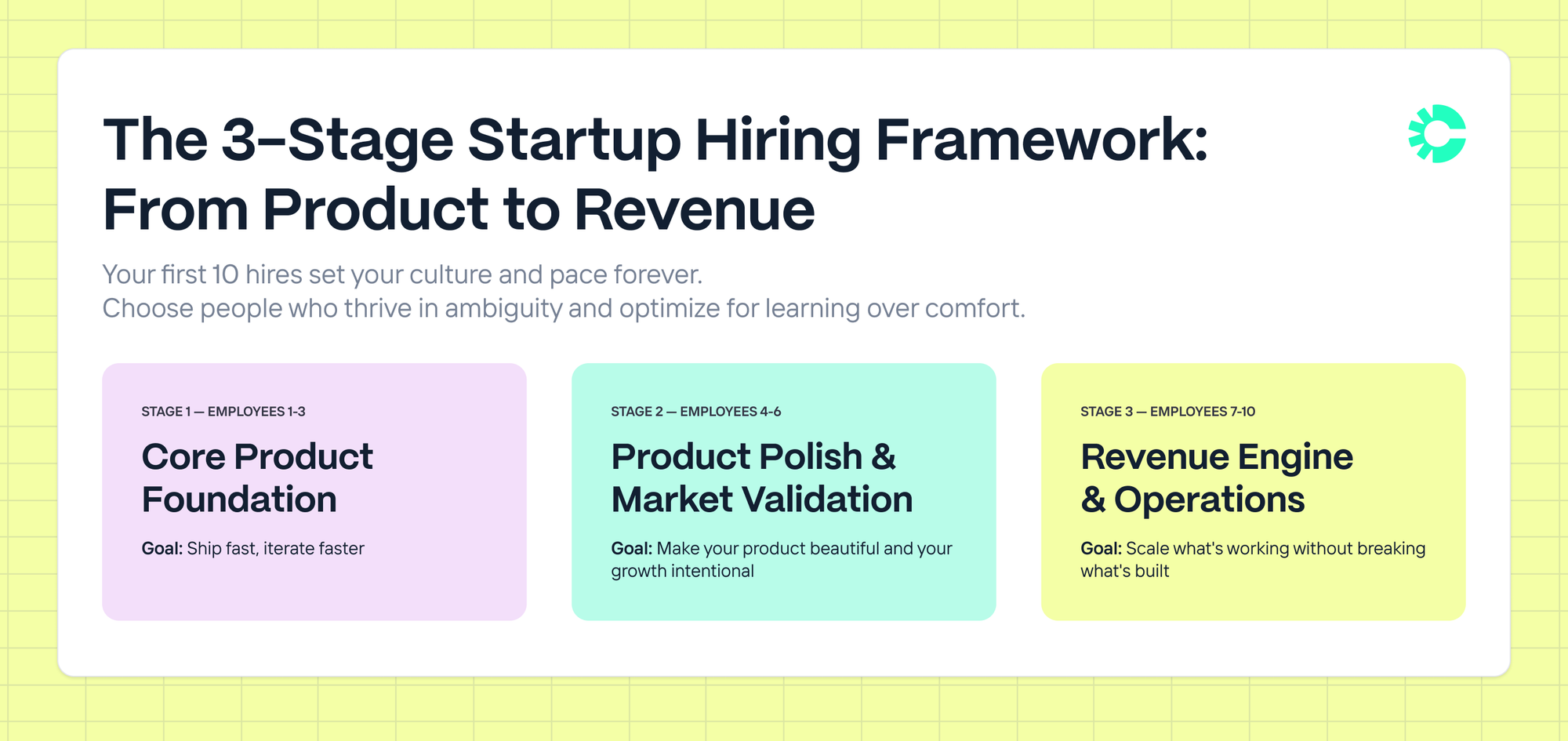These first 10 hires will make or break your startup

Most startup advice gets one thing wrong.
Everyone talks about your "first 5 hires" — but here's the reality: the first 10 employees you hire and the first 10 customers you have will make or break your company.
After building multiple startups, including Iteratively (acquired by Amplitude) and now Clarify, I've learned that early hiring decisions create exponential effects that most founders drastically underestimate.
It's not just anecdotal. According to industry data, 46% of newly hired employees will fail within 18 months, with 89% of these failures due to poor attitudes rather than lack of technical skills. What’s more, nearly half of businesses fail within their first five years. Clearly, at least in part, due to these less-than-stellar employees.
This is why this article exists: to share the frameworks, sequencing, and hard-won lessons that can help founders make better early hiring decisions. If you get the first 10 hires right, everything else — speed, culture, customer experience — starts working in your favor. Get them wrong, and you'll spend years trying to correct the trajectory.
Why 10, not 5?
The conventional wisdom stops at five because it feels manageable. But this framing is part of the problem.
Your first 10 employees don’t just fill roles — they shape the way your company works. At Clarify, we hired several people we’d worked with before because we already knew how they operated. We’d been through the messy stages of team development together, and that allowed us to move faster from day one.
On the flip side, I’ve seen firsthand how a single mis-hire in your early team can throw everything off. It’s not just that the work suffers — it’s that speed, morale, and trust can unravel. Worse, a mis-hire in your first 10 can drive away the people who actually were working.
This is why we treat early hiring with such intentionality. The cost of getting it wrong isn’t just productivity. It’s direction. It’s belief.
The same principle applies to your first 10 customers. They’re the ones giving feedback, shaping your roadmap, and validating your early assumptions. If they’re the wrong fit, you risk building the wrong product.
In both cases — early hires and early customers — you’re locking in the gravitational pull of your company. And everything else you build will orbit around these initial decisions.
The investment-first framework
Most founders hire reactively. They feel a pain, then post a job.
But high-leverage startups hire proactively.
Think of your company as a machine. There are inputs and outputs. You can't brute-force outcomes without upgrading the inputs.
Take revenue: If your goal is $1 million in annual recurring revenue (ARR), you need roughly $4 million in pipeline. That’s just basic conversion math. If marketing generates pipeline, then your investment in marketing should lead your sales hiring.
At Iteratively, our head of growth, Francisca, was that kind of unlock. She gave me back 30% of my time and was better at the job than I ever was. We hired her six months too late.
She didn’t just help us execute. She helped us operate. That extra time allowed me to focus on fundraising, on hiring, on vision — on the work that only I could do. Founders often underestimate the cost of doing everything themselves for too long. But it’s not a cost in stress or hours. It’s a cost in missed leverage.
At Clarify, we repeated this mistake with design. Hiring a designer early completely changed the product. It wasn’t just usable — it became elegant. But that hire came at employee 9 or 10. We waited too long.
The learning: Investment should always lead function. Don’t hire a seller who can’t generate pipeline. Don’t wait to hire for growth until you’re drowning in opportunity.
When you're thinking about your first hires, ask not just: "What problem are we solving today?" but: "What investment will unlock the next wave of momentum?"
Sequencing that actually works
Here’s the hiring structure we follow now:

Employees 1–3: Core product foundation
Engineers who aren’t just coders — they think like product people. You want builders who care about what to build and why. This reduces your need for project managers (PMs) or designers right out of the gate.
And if you can find people who’ve worked with you before, even better. You skip the awkward early phases of team formation. You already trust each other. You can move immediately.
Employees 4–6: Product polish and market validation
This is where you bring in a designer (huge unlock for perceived value) and growth-minded marketer. These roles amplify everything you've built and can dramatically improve how prospects perceive your product quality. Your product becomes more intuitive. Your messaging gets tested. Growth becomes deliberate, not accidental.
Employees 7–10: Revenue engine and operations
Once you've confirmed product-market fit through founder-led sales, it's time to expand. Bring on a salesperson. Hire someone to run operations. Add your first customer success hire.
But timing is everything. Hire too soon, and you waste precious capital. Hire too late, and you lose momentum. Either mistake can be costly.
The biggest sequencing failure? Technical founders often under-hire in go-to-market, while others over-hire GTM roles before validating that their product actually sells.
The misalignment risk
One of the deadliest early-stage killers isn’t bad output — it’s employee misalignment.
Early misalignment isn’t philosophical. It’s operational.
- Can this person make good decisions with limited context?
- Do they thrive at pace or get overwhelmed?
- Can they fail, learn, and self-correct?
- Do they step up or wait for direction?
You can’t afford people who wait. You need people who act.
You also need clarity around roles. Who owns what? Who makes which decisions? Ambiguity here isn't empowering — it's paralyzing.
Startups move fast. This means decisions get made quickly. You need people who are comfortable operating with intuition and imperfect data. Who don’t need permission to fix what’s broken. And who can keep going even when the map runs out.
The big company trap
If you're coming out of a FAANG job (which consists of Meta [formerly Facebook], Amazon, Apple, Netflix, and Alphabet [formerly Google]) and you’re bringing that hiring playbook to your startup, stop now.
You don’t need an executive assistant (EA). You don’t need a full-time website manager. You need people who can figure things out and do more with less.
At a big company, 6 people own 1 project. At a startup, 1 person owns 6.
When you over-assign responsibilities based on legacy structures, you bloat your team before you even start moving.
Startups aren’t efficient because of tooling. They’re efficient because constraints force clarity.
And mindset matters. I've seen too many hires flounder because they were used to having things done for them. At a startup, you're the one doing the thing. You're the one making the call, taking out the trash, stocking the fridge. If that sounds beneath you, you're not ready for early-stage work.
The network effect you can actually control
At Clarify, we hired people we’d worked with before. Not just because of trust, but because we skipped the forming, storming, and norming stages of team development.
People who work well together pull more good people in.
Take Igor. He joined us early in his career at our last company. Two years of experience. No flashy credentials. But high potential and huge appetite for growth.
Now, 5+ years later, he’s back with us. One of the best engineers we’ve got.
The lesson? Hire for trajectory, not just track record.
People optimizing for learning and challenge will outpace those optimizing for status or salary.
And when you get this right, you don't just get talent. You get gravity. “A” players pull other “A” players in. They become your best recruiters.
The AI multiplier
Here’s what’s wild about building teams in 2025:
Designers can write code. Engineers can ship designs.
Thanks to tools like Cursor and Copilot, your team isn’t limited by job title.
We’ve seen people do in a day what used to take a week. And it’s changed how we hire.
We’re looking for people who adapt fast, leverage AI, and compound their impact. Not ones who need a full playbook or task list to start moving.
What this means is your early hires need to be even more adaptable. You're hiring for today, yes. But more than that, you're hiring for who they'll become in a year. Two years. Three.
What actually matters when you hire
Forget resumes. Here’s what we optimize for:
1. Values over experience
Ask: "When’s the last time you made someone else better at work?" If they don’t have an answer, that’s a red flag.
2. Learning over status
Are they here to grow or coast? Look for velocity, not tenure.
3. Startup readiness
Will they take out the trash? Literally. If they think they’re above manual work, they’re not right for an early team.
4. Ownership instinct
Ask: "What’s one thing you’d change about how we work?" If they’ve got nothing, they might not push us forward.
What you gain when you get it right
A bad hire can cost you upwards of a year’s salary. But the real loss is time, morale, and momentum.
Early on, we stayed flat — no formal hierarchy — until we hit 8-10 people. This gave us visibility and agility. No unnecessary layers.
You don’t need managers early. You need owners. People who take initiative and bring clarity.
And your early team will become your cultural ambassadors. They will define how decisions get made. How customers get treated. How new hires are welcomed. They will set the tone for everything that follows.
2025 makes this even more urgent
As of early 2025, lean teams are no longer the exception — they’re the baseline. Startups raising seed rounds today typically operate with small teams — often between two and ten employees — and investors increasingly expect founders to prove early traction with fewer resources and leaner operations.
While hiring has picked up slightly from the freezes of 2023, the expectations have shifted. Founders are under pressure to prove traction with tighter headcount and shorter runway.
The result? A high-supply, high-risk talent environment. The market is full of available talent — but not all of it is ready for early-stage work. Some candidates are optimizing for safety, not stretch.
Ask yourself: Who’s ready to operate without guardrails? Who can handle ambiguity and still execute? Who’s here to help build something meaningful — not just update a resume?
Why your first 10 hires matter most
Your first 10 hires aren’t just early employees. They’re co-founders in disguise.
They define your speed, your culture, your gravity.
Most startups don’t fail because of market or product. They fail because they couldn’t execute. And execution is people.
Hire intentionally. Hire from the future you want to build.
Get our newsletter
Subscribe for weekly essays on GTM, RevTech, and Clarify’s latest updates.
Thanks for subscribing! We'll send only our best stuff. Your information will not be shared and you can unsubscribe at any time.
